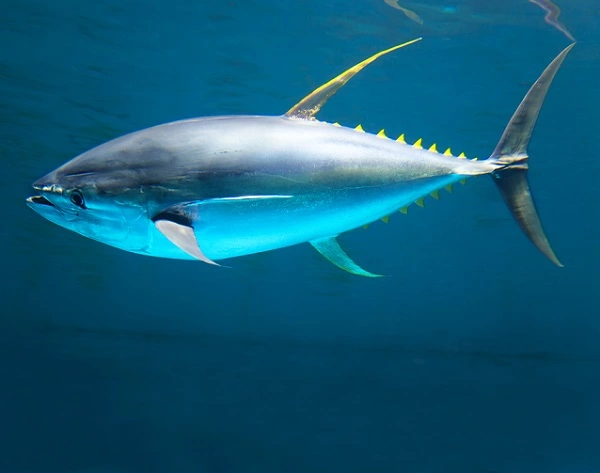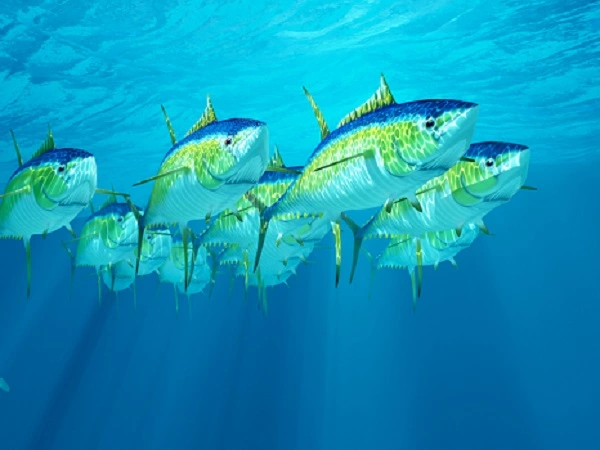The yellowfin tuna is a large, predatory fish that is found in both the Pacific and Atlantic oceans. These fish can grow up to six feet in length and weigh up to 350 pounds. While they are popular for sport fishing, they are also commercially important as a source of seafood. Yellowfin tuna are considered a delicacy, and their flesh is considered some of the most flavorful in the ocean. In this blog post, we will take a closer look at the yellowfin tuna animal. We will explore their habitat, diet, and behavior, as well as discuss some of the threats they face in the wild.

Yellowfin Tuna Description
The yellowfin tuna is a variant species of the tuna fish found in the tropical and subtropical pelagic waters of the oceans, worldwide. They are fast swimmers and can reach speeds of up to 50 miles per hour. Yellowfin tuna are predators and feed on a variety of fish, squid, and crustaceans. Yellowfin tuna are an important food fish and are commercially fished all over the world. Yellowfin tuna steaks are popular among seafood lovers and are often grilled or baked. Yellowfin tuna are also canned and used in a variety of dishes such as sushi, sashimi, and ceviche.
Yellowfin Tuna Habitat
Yellowfin Tuna are found in tropical and subtropical waters around the world. They typically inhabit offshore waters, but can also be found in coastal areas. Yellowfin Tuna are highly migratory fish, and their movements are influenced by a variety of factors, including water temperature, food availability, and spawning. Yellowfin Tuna typically spawn in warm oceanic waters, and their larvae are carried to other areas by currents. As Yellowfin Tuna grow, they gradually move to deeper waters. Yellowfin Tuna are predators, and their diet consists primarily of fish and squid. Their keen eyesight and powerful sense of smell help them to locate prey. Yellowfin Tuna are an important species both commercially and ecologically. They are prized for their flesh, which is used for a variety of purposes, including canned tuna, sushi, and sashimi. Yellowfin Tuna are also a major predator in the marine food web, and their populations can have a significant impact on the structure of oceanic ecosystems.
Yellowfin Tuna Diet
Yellowfin tuna are apex predators, meaning they sit at the top of the food chain. They play an important role in maintaining the balance of the ocean ecosystem. Yellowfin tuna are carnivorous and their diet consists mostly of other fish, squid, and crustaceans. Their diet can vary depending on their location and the availability of prey. Yellowfin tuna are migratory creatures and travel great distances in search of food. Their powerful body and large fins allow them to cover vast distances in a short period of time. Yellowfin tuna are one of the most commercially valuable fish in the world. They are highly sought after by both recreational and commercial fishermen. The high demand for yellowfin tuna has led to overfishing in many areas, which has had a negative impact on the species. Yellowfin tuna are now listed as commercially exploited by the International Union for Conservation of Nature (IUCN).

Yellowfin Tuna Size
Yellowfin tuna are one of the largest species of tuna, with some individuals reaching sizes over 10 feet and weights of over 1,000 pounds. Yellowfin tuna have a deeply forked tail and bright yellow fins, giving them their name. Yellowfin tuna are found in tropical and subtropical waters around the world, and are prized by both recreational and commercial fishermen. Yellowfin tuna are fast, powerful swimmers, and are known for their acrobatic leaps out of the water. Due to their size and value, yellowfin tuna are also one of the most heavily exploited species of fish in the world. Overfishing, bycatch, and habitat destruction have all contributed to declining populations of yellowfin tuna in recent years. As a result, yellowfin tuna are now considered to be an endangered species.
Yellowfin Tuna Lifespan
Yellowfin tuna are one of the largest species of tuna, and can live for up to 12 years. However, their lifespan is highly dependent on their environment and conditions. In the wild, Yellowfin tuna face many predators, including sharks and other large fish. They also suffer from high levels of fishing pressure, as they are a popular target for both commercial and recreational fishermen. As a result, Yellowfin tuna often do not live to reach their full potential lifespan. In captivity, Yellowfin tuna have a much higher survival rate, as they are protected from predators and fishing pressure. However, they still suffer from many of the same health problems as their wild counterparts, and often do not live more than 10 years. Overall, Yellowfin tuna have a wide range in lifespan, depending on their environment and conditions.
Yellowfin Tuna Behavior
Yellowfin tuna are one of the most important commercial fish species in the world. They are highly sought after for their delicious flesh, and they are also popular as a game fish. Yellowfin tuna are found in tropical and subtropical waters around the world, and they migrate long distances between feeding and breeding grounds. Because of their size and power, yellowfin tuna are apex predators in their marine ecosystem. Yellowfin tuna are opportunistic feeders, and they prey on a huge variety of smaller fishes, squid, and crustaceans. Yellowfin tuna are powerful swimmers, and they have been known to reach speeds of up to 80 km/h. Their bodies are streamlined and sleek, which helps them to move through the water with ease. Yellowfin tuna are fascinating creatures, and they play an important role in both commercial fisheries and the marine ecosystem.
Yellowfin Tuna Speed
Yellowfin tuna are one of the fastest fish in the ocean. They can swim up to 50 miles per hour (80 kilometers per hour). Yellowfin tuna are usually found in tropical and subtropical waters. They are often seen near the surface, but they can dive down to depths of 3,000 feet (900 meters). Yellowfin tuna are very important to commercial and recreational fisheries. They are caught all over the world and are used for food, bait, and sportfishing. Yellowfin tuna are also popular in aquaculture.
Yellowfin Tuna Hunting
Yellowfin tuna are one of the most popular fish among sport fishermen. They are known for their fighting spirit and acrobatic leaps, as well as their delicious flesh. Yellowfin tuna are found in tropical and subtropical waters around the world, and are often associated with coral reefs. They are relatively large fish, growing up to two meters in length, and can weigh up to 150 kg. Yellowfin tuna are predators, feeding on smaller fish, squid, and crustaceans. They are an important food source for humans, and are also prized by the Japanese for their raw fish Flesh. Yellowfin tuna are generally considered to be a sustainable seafood choice, but there is some concern about overfishing. Sport fishing for yellowfin tuna is regulated in many areas in order to ensure the survival of the species.
Conclusion
The yellowfin tuna is a large, predatory fish that is found in tropical and temperate waters throughout the world. This powerful fish can reach speeds of up to 50 miles per hour and weigh up to 400 pounds. The meat of the yellowfin tuna is prized for its flavor and texture, making it a popular choice for sushi and other dishes.
Frequently Asked Question


